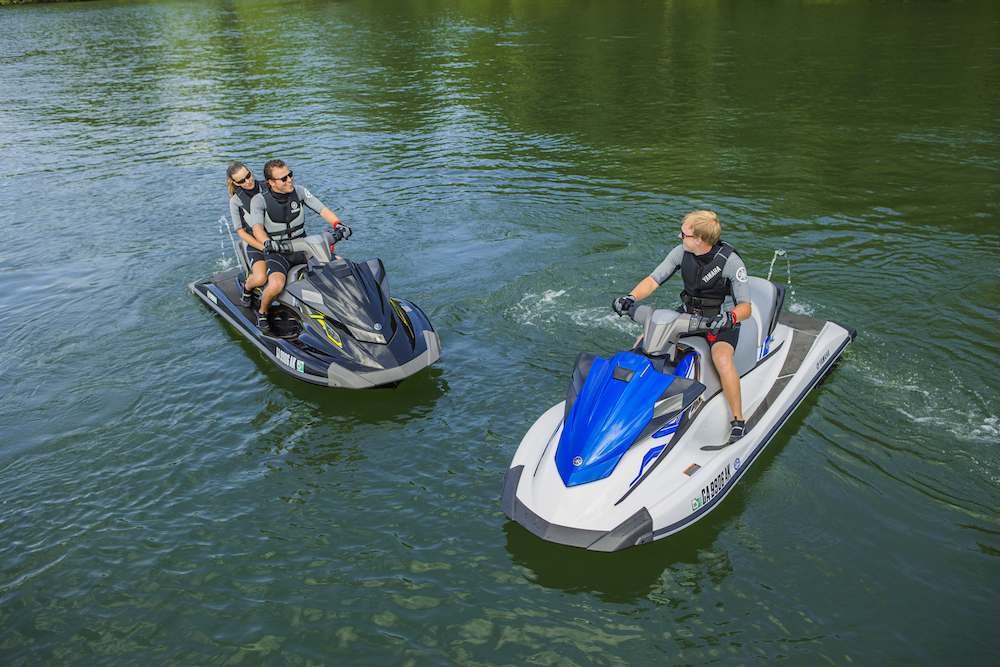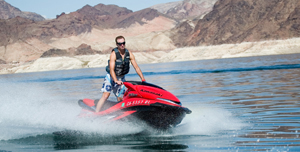Personal Watercraft (PWC) and Jet Ski Buyer's Guide
Thinking about buying a personal watercraft (PWC)? Check out our WaveRunner and Jet Ski Buyer's Guide to help get you started—before you know it, you'll be out on the water.
A PWC (personal watercraft) is technically a powerboat, but only because it floats. The acceleration, speed and agility of PWC offer an experience that feels like riding a high-performance motorcycle on the water. PWC also offer an affordable entry point to power-boating. Even the most expensive, feature-laden new PWC costs much less than a modest pre-owned runabout, and the PWC is easier to own; fuel and annual maintenance cost less, a pair of PWC can be towed with a compact SUV or van, and in the off-season two will fit on a trailer in your garage.
Riding a PWC like a Jet Ski is an intimate experience that’s not for everyone. You are in the wind and spray and close to the waves. You can bring along a passenger or two but a PWC lacks the social element many people enjoy with a powerboat. On a PWC you can do just about anything you’d do with a boat—cruise, tow a boarder or a single-rider tube, hang at the beach or the cove or even fish—but life on the water is just different with a PWC. Most owners think it’s a lot more fun.

Ready to jump into the world of PWCs? Be sure to do your research before you buy.
A Different Kind of Dealer
Almost all new PWC are sold by powersports dealers, which also may sell motorcycles, ATVs, snowmobiles and all of the gear and accessories associated with those products. The atmosphere at a powersports dealership will be much different from what you’ll encounter at a typical marine dealership. The staff at a powersports shop will usually be younger and the energy level will be high. Powersports dealers are used to closing deals pretty quickly; compared to a powerboat the cost of a PWC or motorcycle is much lower and it’s not unusual for a customer to pick up a new PWC almost as an impulse purchase, especially right before a holiday weekend. A powersports dealer can help facilitate the sale with financing and registration filing, and there are often financing deals and rebates available through the manufacturer. Many powersports dealers will also stock pre-owned PWC, and offer riding apparel, tubes and towlines, and other accessories. The dealer will also stock PWC trailers, which are sold separately.
The Pre-Owned Option
Great deals can be found on pre-owned PWC in local classifieds and sites like Boats.com. Many PWC were purchased for use at a waterfront home or cottage alongside a powerboat, sailboat, and a swim raft. As a result the PWC may have seen only occasional use and even after five or six seasons have very low hours. Like the purchase of any pre-owned vehicle, buying a used PWC is strictly a “buyer beware” situation, so you’ll want to kick the tires more than once. Our advice: Avoid defunct brands (Polaris, Tigershark, etc.) because parts and service could be a problem. Avoid older PWC powered by two-stroke engines, which are not as durable as newer four-stroke engines and more prone to mechanical issues. Walk away from any used PWC that has an engine modified with high-performance parts that could compromise reliability. Service records or a service history from a dealer as a big plus, and will show that the craft has had an annual oil change, fresh filters, and proper winterization. The general appearance of the craft is a good indicator of how it’s been used; is there a stain or scum line on the hull that indicates the craft was stored in the water rather than on a trailer or lift? Is the seat or handlebar pad sun faded? Does the hull show deep scratches or damage from running on a rocky bottom? Plenty of used PWC really are in “like new” condition and that’s what you want to buy.

Stand up or sit down?—that's one of many decisions you'll need to make when purchasing a PWC.
Decisions, Decisions
According to research shared with us by Yamaha, the typical duty cycle for a PWC lasts only 20 minutes; the owner, a family member or guest gets on the craft, rides around for about 20 minutes and then returns to the dock. Then it’s someone else’s turn. However, we’ve already established that there’s a lot more you could do with a PWC, so a smart way to buy is to get as much versatility as possible in the PWC model you select. Here are some factors to consider.
Seating Capacity
Almost all current PWC models are rated to carry three passengers. If you want to do any kind of towing—wakeboarder or tube—this three-passenger capacity is a must because it’s required by law in most states; one position is designated for the driver, one position is an observer, and the third spot is for the person in the water, should they become tired or injured. There are smaller and more-affordable models—the Sea-Doo Spark and Yamaha WaveRunner EX and WaveRunner VX models—that are rated for three passengers but in reality only offer practical, or comfortable, room for 2.5 passengers, like two adults and a child. If your plan is to do a lot of riding with the pilot and a passenger on board, whether that’s because you are towing or touring a longer distance, a larger model like the Yamaha WaveRunner FX, Sea-Doo GTX and Kawasaki Jet Ski Ultra and STX series, will offer more seat room and more stability than a smaller model.
Power
Compact three-seat PWC like the Yamaha WaveRunner EX and VX models, Sea-Doo GTS and GTI and Kawasaki Jet Ski STX are offered with a 90 to 155 horsepower engine and are capable of a top speed of 45 to 50 MPH. Full-size and full-feature models like the Yamaha WaveRunner FX series, Sea-Doo GTX and Kawasaki Jet Ski Ultra models offer 180 to 300 horsepower engines—that’s a lot of power in what is essentially a 12-foot boat. The highest-performance models offer explosive acceleration—zero to 60 MPH in less than four seconds – and a top speed approaching 70 MPH with a light load of fuel and a single rider. Models in the 180 to 250 horsepower range offer plenty of power for towing or riding two-up and will still run about 65 MPH. The more-powerful models are actually electronically governed not to exceed 67 MPH, but the aftermarket offers easy solutions to “uncork” the full performance potential of these craft. Performance at the top level demands respect from the rider and a certain level of experience and self-restraint, so the most-powerful PWC are probably not the best choice for beginners or family use. If you’re looking for a PWC that will be another fun option at the lake – for those 20-minute rides—and may be shared by a number of riders, a less-powerful model is the way to go. Note also that most PWC have a “learning mode” that’s activated by a special key or a remote control fob that electronically limits engine performance, so the craft accelerates at a slower rate and top speed is capped at about 45 MPH.

A trailer is a must-have necessity for any PWC owner.
Key Extras
Trailer:
A trailer is sold separately although it may be included in a package offered by a dealer. Trailers are available to tote one to four PWC. Even if you live on the water and keep the PWC on a lift, you’ll need a trailer to launch and retrieve each season and for off-season storage and transport for service.
Riding Gear:
You’ll need a good-fitting vest-style (Type III) life jacket for each rider. Neoprene shorts or riding trunks with a neoprene liner are highly recommended for comfort and protection. A thin rashguard shirt that’s worn under the life jacket prevents chafing and may offer up to 50 SPF UV protection.
Tube:
Tubing behind a PWC is as much fun as tubing behind any powerboat, but in most states that tube can only carry a single person, so a smaller, single-rider tube will be the best choice if it’s only going to be used behind the PWC. For tubing you’ll also need a tow line. Check your state regulations regarding other towing requirements.
For more information on PWCs, Jet Skis and WaveRunners, be sure to read Choosing the Right Personal Watercraft (PWC).












